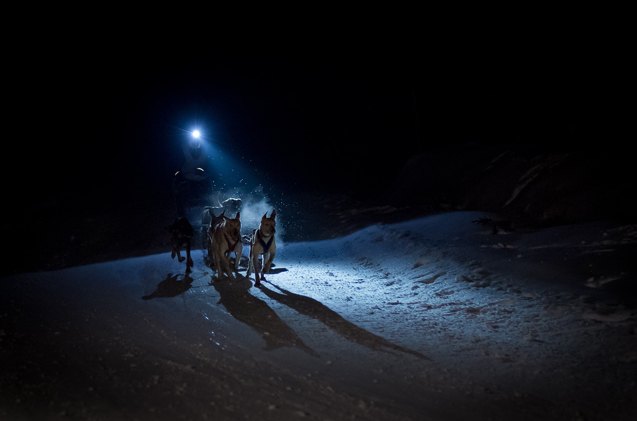How To Choose a Headlamp for Night Time Dog Mushing

If you’re like me, you need to have a day job in order to support your mushing habit. This means I run my dogs before or after work, often in the dark. Loading gear, harnessing dogs, checking feet and seeing where we are headed are all important – that’s why I rely on a headlamp.
For the first-time buyer, choices in headlamps can be a little overwhelming. This handy guide will light the way to the headlamp that’s right for you.
Switch: Before I even get into the technical aspects of a light, I check out if it can be easily operated with my gloves on. If I can manipulate the buttons with gloves, it’s useful. Some buttons are so small to press that there’s no way you’re going to be able to use it on the trail. Always bring your gloves with you to the store to test out headlamps.
Related: How to Find the Right Urban Mushing Instructor
Beam Type: There are two types of beams: Flood and Spot. With Flood beams, think wide, not deep. This beam is perfect for sorting out gear at the truck and can be useful for hitching dogs up to your rig. With Spot beams, think “Spot on” – this is a light you can focus ahead on the trail so you see where you are going.
The most useful headlamps for mushing are adjustable Flood/Spot lights. By flicking a switch or pressing a lever, you can convert it from one beam to another. And remember my tips for switches – you need to be able to operate it with gloves on.
Many lights have a Red Light Setting as well (no, not that kind of red light!). These red lights help preserve your night vision, as well as the night vision of the dogs.
Related: What’s the Difference Between a Kick Sled and a Dog Sled?
Some headlamps offer a tilt feature. These are handy to be able to direct the beam where you need it. Not all tilting mechanisms are created equal. Some lights works on a flimsy plastic hinge, which may bounce around. Look for a headlamp that offers a sturdy titling system.
Lumens and Beam Distance: Lumens are fancy talk for how much light is sent out from a light source. Generally, a higher lumen light is going to be brighter. But all those lumens come at a cost – the higher the lumens, the more battery power your light is going to need. Some headlamps will advertise run time, but these are under ideal conditions. In extreme cold, with a long beam, your headlamp is going to be pushed harder than a spotlight on a mild evening.
Going hand in hand with lumens, beam distance tells you how many meters a headlamp can project light. Think of your setup, and how far out you want to project. Dogs generally don’t need the same light as us to run in the dark, but you will still want to be able to see far enough down the trail to ensure a safe run.
Batteries: Lithium batteries are the best choice for cold weather, followed closely by rechargeable nickel metal hydride ( NiMH) batteries. Rechargeable batteries don’t hold their power as well, so unless you are using it often and are good at charging, stick with the lithium.
Batteries can be mounted behind the light, so they ride up around your forehead, or in a battery pack at the back. Personally, I prefer headlamps with batteries right behind the light. I find some battery packs flop around, and are difficult to fit around a helmet.
Manufacturers have begun to add a feature called “regulated output”. Most headlamps get gradually dimmer as they use up the battery power. This is often so gradual that you may not even notice it until you suddenly can’t see your lead dog. Headlamps that operate using regulated output don’t have this problem. But, rather than getting dimmer slowly, they will suddenly lose power. Not so fun. Whether you choose regulated output or not, it’s a great idea to carry an extra set of batteries.

Kevin Roberts lives for adventure. Together with his pack of rescue dogs and his husband, he spends as much time outdoors as possible. Kevin lives by the motto: "Get outside and play with your dogs!
More by Kevin Roberts























